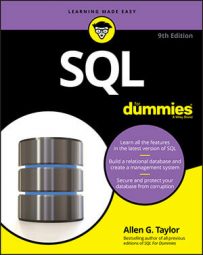Suppose your business has a CUSTOMER table that keeps track of all your customers and a SALES table that records all sales transactions. You don’t want to add a row to SALES until after you enter the customer making the purchase into the CUSTOMER table. You also don’t want to delete a customer from the CUSTOMER table if that customer made purchases that exist in the SALES table.
Before you perform an insertion or a deletion, you may want to check the candidate row to make sure that inserting or deleting that row doesn’t cause integrity problems. The MATCH predicate can perform such a check.
Say you have a CUSTOMER table and a SALES table. CustomerID is the primary key of the CUSTOMER table and acts as a foreign key in the SALES table. Every row in the CUSTOMER table must have a unique CustomerID that isn’t null.
CustomerID isn’t unique in the SALES table, because repeat customers buy more than once. This situation is fine; it doesn’t threaten integrity because CustomerID is a foreign key rather than a primary key in that table.
Seemingly, CustomerID can be null in the SALES table, because someone can walk in off the street, buy something, and walk out before you get a chance to enter his or her name and address into the CUSTOMER table. This situation can create trouble — a row in the child table with no corresponding row in the parent table.
To overcome this problem, you can create a generic customer in the CUSTOMER table and assign all anonymous sales to that customer. Say that a customer steps up to the cash register and claims that she bought an F-35 Strike Fighter on December 18, 2012. Although she has lost her receipt, she now wants to return the plane because it shows up like an aircraft carrier on opponents’ radar screens.
You can verify whether she bought an F-35 by searching your SALES database for a match. First, you must retrieve her CustomerID into the variable vcustid; then you can use the following syntax:
... WHERE (:vcustid, 'F-35', '2017-12-18')
MATCH
(SELECT CustomerID, ProductID, SaleDate
FROM SALES)
If the MATCH predicate returns a True value, the database contains a sale of the F-35 on December 18, 2017, to this client’s CustomerID. Take back the defective product and refund the customer’s money. (Note: If any values in the first argument of the MATCH predicate are null, a True value always returns.)SQL’s developers added the MATCH predicate and the UNIQUE predicate for the same reason — they provide a way to explicitly perform the tests defined for the implicit referential integrity (RI) and UNIQUE constraints.
The general form of the MATCH predicate is as follows:
<i>Row_value</i>MATCH [UNIQUE] [SIMPLE| PARTIAL | FULL ] <i>Subquery</i>The UNIQUE, SIMPLE, PARTIAL, and FULL options relate to rules that come into play if the row value expression R has one or more columns that are null. The rules for the MATCH predicate are a copy of corresponding referential integrity rules.

